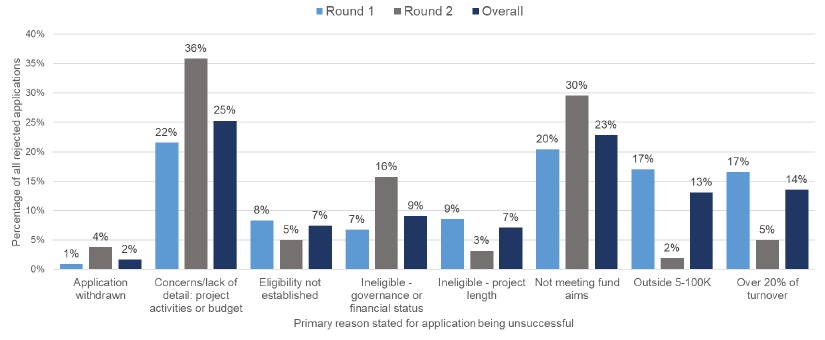Wellbeing Fund: analysis of awards
Analysis of the data on applications and awards made through the Wellbeing Fund Open Application Process and the Small Grants Fund. These funds were part of the Scottish Government’s initial 350 million overall package of funding support to communities, in response to the COVID-19 pandemic
8. Primary reasons for applications being unsuccessful
All applications to the Wellbeing Fund bid-in process were assessed by two assessors against a range of criteria. These criteria were intended to ensure that the public funding would be channeled to organisations with strong existing programmes, good project plans, and appropriate financial governance in place. Scottish Government analysis used text analysis to look at the main reasons given by Fund assessors for an application being unsuccessful. The results are shown in the figure below.
In Round One, around 34% of applications were unsuccessful because they did not meet the core fund criteria stating that projects should cost between £5K-£100K, or that project costs should not represent more than 20% of organisational turnover. Recognising this, in Round Two the application process built in technical barriers to ensure that applications would fall within these parameters – with the result that lack of success for these reasons was much less frequent in Round Two.
Reflection on the fund criteria suggests that although there were important reasons for putting these criteria in place, they may have had the unintentional outcome that the fund was less accessible to some organisations in the first round of applications. In the event of a future similar emergency fund being created, more input from the organisations that the fund was seeking to support would help to reduce this risk, if time allowed.
Across both rounds, some 23% of applications were unsuccessful because they did not meet the aims of the fund. This was usually because they were not for projects intended to meet new and acute needs emerging in the context of Covid-19. In many cases, organisations had applied for continuation of existing work, or for costs not related to the proposed project. Similarly, around seven percent of applications were unsuccessful because they were for longer-term work, lasting beyond the three-month term of the project funding.
In Round Two, the most frequent reason for an application to be unsuccessful was insufficient detail or information about a project or its budget – or assessor concern about the quality of the proposal. Assessors often expressed a need for more information about either the project or the budget in order to assess whether it was deliverable and meeting an urgent emerging need within a vulnerable target group. Similarly, assessors also raised concerns about whether budgets represented good value for money in relation to project scale. These types of reasons accounted for 25% of all unsuccessful applications across both rounds. Learning from this could be applied to the design of the application process for any subsequent fund.
Other eligibility criteria accounted for the remaining 24% of unsuccessful applications, primarily relating to the presentation of accounts or the governance arrangements of applicant organisations. In seven percent of these cases, eligibility could not be established due to a lack of accessible documentation or insufficient provision of information.

Contact
Email: socialresearch@gov.scot
There is a problem
Thanks for your feedback